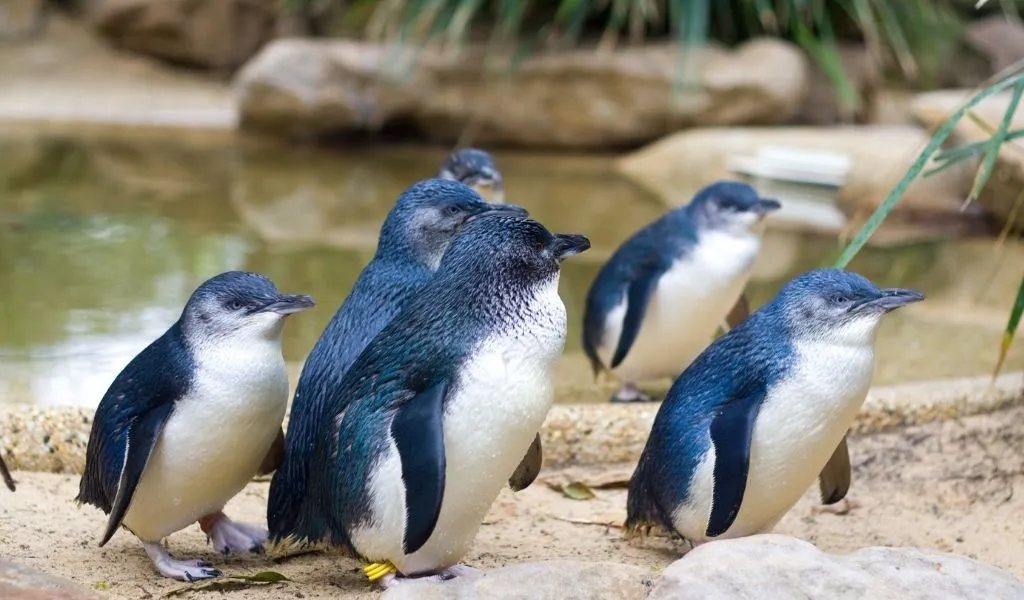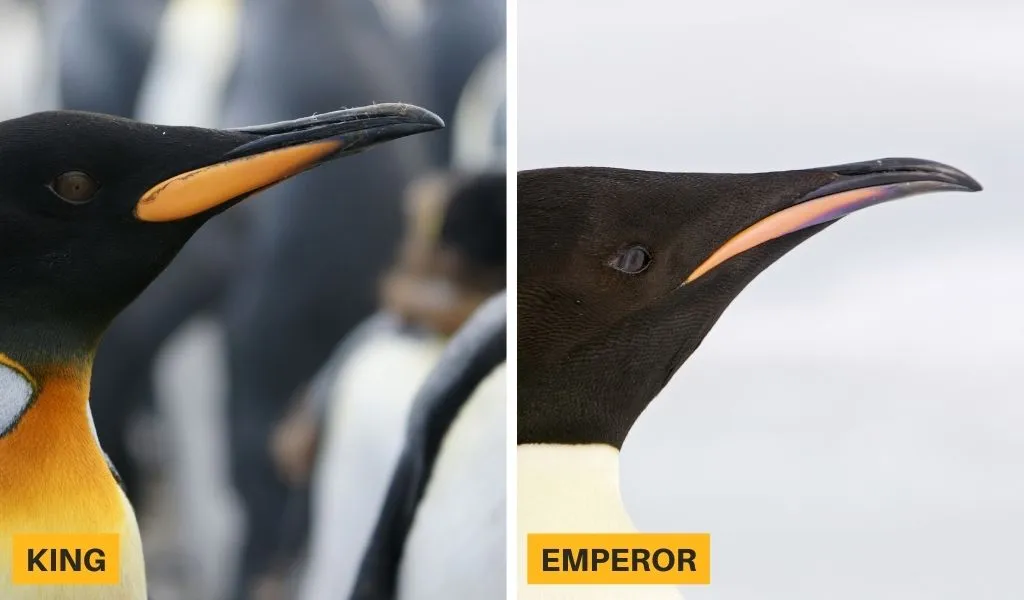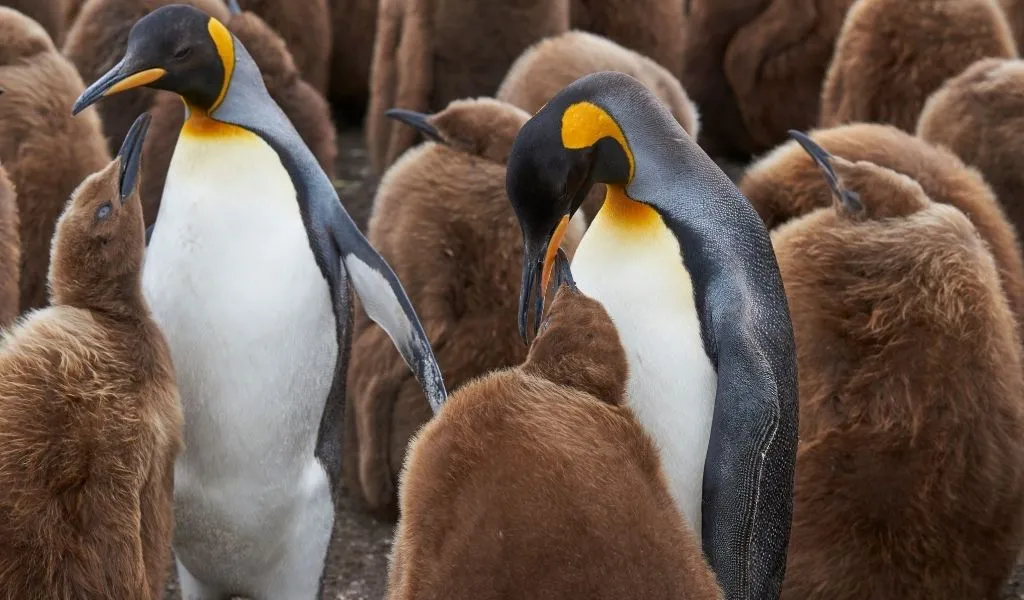Penguins are dressed to impress with their tuxedo-like appearance and colorful ‘accessories’ across their body such as yellow crests, pink feet, and orange spots on their beaks. But have you ever stopped to ask yourself why penguins are this color?
Adult penguins have black and white feathers on their body which provide camouflage from predators in the water and in the air. Baby penguins are grey, white, or brown until they grow their waterproof adult feathers. Some species even have a golden-yellow or orange patch on their crest or neck which signals their healthiness to potential mates.
Keep reading to find out more about why penguins are the colors they are or check out our penguin facts to learn more about our tuxedo-wearing friends.
Why Are Penguins Black And White?
Penguins are white on their ventral (belly) and black on their dorsal (back), this is called countershading and provides better camouflage for them in water.
When seen from below, their white ventral blends with the lighter surface waters above, and when seen from above, the black dorsal provides camouflage against the darkness of deeper waters below1 (source: H.M. Rowland, The Royal Society B Biological Sciences, Issue 364, 2008).
The black coloration makes them more visible on land, however, this is a reasonable sacrifice since they spend most of their time in water and most, if not all, of a penguin’s predators are aquatic.
Their white and black feathers also provide a secondary purpose by helping penguins to regulate their body temperature whilst on land.
When they are cold, they turn their backs towards the sun as black is better at absorbing heat and when they are warm, they turn their bellies towards the sun as this reflects the heat2 (source: J. Chester, The Nature of Penguins, 2001).
Why Are Some Penguins Blue?

Not all penguins are black and white, Little Penguins (also known as Fairy Penguins or Little Blue Penguins) appear to have blue or dark grey feathers on their backs.
Blue is a popular color among birds and is considered to be more attractive to potential mates. The blue color of the Little Penguin is produced by tiny bundles of nanofibers in their feathers that refract blue light and absorb other colo3rs (source: D.T. Ksepka, American Scientist).
Similar to other penguin species, Little Penguins also use countershading with a white belly and darker colored back to blend in when they are in the ocean.
What Color Are Penguins Feet?
The color of a penguin’s feet will vary by species with some having lighter colored pink or orange feet and others having darker black feet. Some research suggests different colored feet are adaptations to regulate penguin body temperature and help swimming in water at different temperatures4 (source: D.T. Ksepka, American Scientist).
For example, Chinstrap, Gentoo, and Rockhopper Penguins have pink or orange/red feet with black soles, whereas King and Emperor Penguins have black feet5 (source: P.D. Boersma and P.G. Borboroglu, Penguins: Natural History and Conservation, 2013).
What Color Are Penguins Eyes?
The eye color of penguins varies by species and age. As chicks, penguins have a dark iris which then becomes paler as they age before eventually turning more red or brown into adulthood. Did you know penguins cannot see red?
Some species continue to have pale iris colors throughout their life such as the Little Penguin or Yellow-Eyed Penguins. Adelie, King, and Emperor Penguins have the darkest iris color as adults.
It is thought that the color of the iris is related to the latitude at which the penguins are found. Remember, penguins live all across the southern hemisphere, from the cold Antarctic to the warmer climate of Australia and New Zealand.
A darker color will absorb more radiant energy and is more likely to be found among southerly penguins where the temperatures are colder6 (source: C.J. Scholten, Marine Ornithology, Vol 27, 1999). According to these theories, this is why Adelie, King, and Emperor Penguins have the darkest eyes because they live in or near Antarctica. Whereas Humboldt and Galapagos Penguins have lighter colors.
The below table shows the eye color of different penguin species at different life stages:
| Penguin Species | Eye Color (Chick) | Eye Color (Juvenille) | Eye Color (Adult) |
|---|---|---|---|
| Royal Penguin | Dark | Dark | Red |
| Emperor Penguin | Dark Black | Dark Brown | |
| Adelie Penguin | Dark Grey/Brown | Dark or Pale Brown | Dark Brown |
| Humboldt Penguin | Dark | Dark or Pale | Pale Red |
| Magellanic Penguin | Dark | Dark Brown | |
| Fiordland Penguin | Red | ||
| Yellow-eyed Penguin | Dark Brown | Pale | |
| Snares Penguin | Grey or Brown | Reddish Brown | |
| Macaroni Penguin | Red, Reddish Brown, or Brown | ||
| Galapagos Penguin | Dark | Red or Dark Brown | |
| Erect-crested Penguin | Brown | ||
| African Penguin | Pale, Red, or Brown | Brown | |
| Chinstrap Penguin | Dark Grey | Dark-Pale | Reddish Brown |
| King Penguin | Dark Brown | Dark Brown | |
| Gentoo Penguin | Dark Grey | Dark Brown | |
| Little Penguin | Dark | Pale | Pale |
| Rockhopper Penguin | Dark or Red | Dark or Red | Red |
What Color Are Penguin Beaks?
Penguins have black beaks that match their black backs, but many species have yellow or orange-colored spots on their beak whilst King and Emperor Penguins also have UV patches that are not visible to the human eye but can be seen by other penguins.

Both colored patched and UV patches on a penguin’s beak play a role in attracting a mate by both males and females. Unlike other bird species where males try to attract females, both sexes of penguin court each other, likely due to the shared role in breeding.
Researchers observed 75 pairs of King Penguins in the Kerguelen Islands who were in the early stages of choosing a mate. They found that beak color was a major factor in whether they went on to form a committed pair and lay eggs or search for a better-suited mate. The study found that King Penguins favor a mate with a similar colored beak to themselves7 (source: I. Keddar, Ethology, Vol 121, Issue 11, 2015).
Beak color is affected by many factors, including fasting and parasites that the penguin may have8 (source: Q. Schull, et al., Behavioral Ecology, Vol 27, Issue 6, 2016).
What Color Are Penguins Feathers?
We already know Penguins have black feathers on their back and white feathers on their belly to provide camouflage but many species also have golden-yellow feathers on the crest of their head or their neck.
Penguins with yellow crest feathers include macaroni penguins, royal penguins, and rockhopper penguins, whilst the closely related king penguin has orange chest feathers which serve the same purpose.
Unlike most other birds which gain unique feather colors from the food in their diet, studies have found that the yellow pigment synthesized by penguins is unique among birds9 (source: D.B. Thomas, Journal of the Royal Society Interface, Vol. 10, Issue 83, 2013).
The yellow color is to attract a mate by demonstrating that they are healthy enough to afford to compromise their camouflage10 (source: D. T. Ksepka, American Scientist).
Penguins with the most extravagant yellow feathers are the most desirable to mates11 (source: D.B. Thomas, et al., Journal of the Royal Society, Interface Vol. 10, Issue 83, 2013). To prove this, researchers reduced the colored patch on a sample of King Penguins by using a black non-toxic marker and observed that it took males with a reduced patch twice as long to find a partner compared to the control group12 (source: P. Jouventin, et al., Ibis. Vol 150, Issue 1, 2007).
Depending upon the species, penguins can also raise or lower their feathers when they are courting or show they are scared.
What Color Are Baby Penguins?
When penguin chicks are born, they are either born without any coat or have a different type of feathers to adult penguins so they are a different color, usually grey, white, or brown.
The first coat of feathers they are born with or develop is natal down, this is not waterproof so baby penguins cannot swim or they’ll risk hypothermia. Penguin chicks also do not require the countershading provided by the black and white coat of an adult if they are not in the water.
They will learn to hunt for themselves once the down has fallen out and is replaced with their first coat of waterproof contour feathers, a process called molting. This is when they will develop the black and white tuxedo-style look we know13 (source: M. Cook Sciencing.com).
Brown and fluffy King Penguin chicks are very different to their adult counterparts and early explorers thought they were a different species which is where they got the name woolly penguins14 (source: National Geographic).

What Color Are Penguin Eggs?
When penguins lay their eggs, they will be white or have a slight blue/green color15 (source: Seaworld). Bird eggs are colored or patterned to help them blend in with their surroundings, this is to protect them from the eyes of predators16 (source: S. Moss, Do Birds Have Knees, 2016).
Although it’s mostly illegal to collect and eat penguin eggs in most countries, if you were to boil a penguin’s egg, the egg white would turn clear rather than white as we are used to with chicken eggs.
This is because penguin eggs have more of a glycoprotein called penalalbumin which helps the eggs survive the cold. Penguin eggs contain 25% penalalbumin whereas chicken eggs contain less than 0.01%17 (source: D.T. Osuga, et al., Journal of Protein Chemistry, 1983).
Related Questions
What Color Are Penguins Nose?
Penguins have a black nose, although it’s difficult to see as it’s made up of two nostrils (called nares) that are incorporated into its beak.

![You are currently viewing Why Are Penguins Black and White? [Full Color Palette Explained]](https://polarguidebook.com/wp-content/uploads/2022/01/What-color-are-penguins.jpg)
![Read more about the article 15 Amazing Facts About African Penguins [#9 Might Make You Squirm]](https://polarguidebook.com/wp-content/uploads/2023/01/African-Penguin-1-300x200.jpg)
![Read more about the article 19 Types of Penguins [+ What Makes Each Unique]](https://polarguidebook.com/wp-content/uploads/2022/12/Types-of-Penguins-300x200.jpg)
![Read more about the article How Do Penguins Swim and Dive So Well? [and Other Questions]](https://polarguidebook.com/wp-content/uploads/2022/01/How-do-penguins-swim-so-well-300x176.jpg)